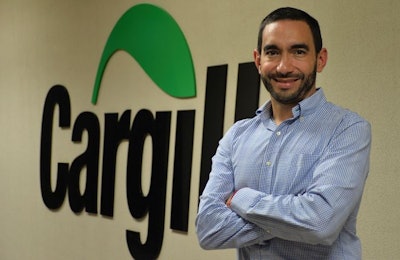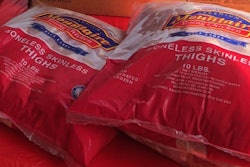
Cargill Protein Latam’s Honduran poultry processing plant Pronorsa, located in San Pedro Sula, is now almost fully functioning after having been hit by two of the worst hurricanes to pass over Honduras in decades. The plant was severely affected by water entry and equipment lost, emergency planning meant that no lives were lost.
No one expected the last hurricane season to be so destructive, despite warnings.
Category 4 Hurricane Eta began to hit Honduras on November 3rd 2020. Exactly two weeks later, the country was struck again, this time by Hurricane Iota, another devastating category 4 hurricane. The impact of the two hurricanes is thought to have set Honduras’ economic development back by 22 years and the country is not expected to fully recover for another 10 years. The number of people in the country facing food security since the hurricanes struck has more than doubled.
No exception
Cargill’s Pronorsa processing plant is located close to a stream that during the rainy season, records a significant increase in water levels. Little surprise, therefore, that the plant has containment walls and shut down protocols in place should the risk of flooding be deemed high.
High water levels are potentially dangerous for the plant for two main reasons. Firstly, the site contains a large, high voltage, electricity substation, while secondly, flooding could result in the release of ammonia, used for refrigeration and freezing, into the surrounding community.

Devastation at the Pronorsa poultry processing plant. | Courtesy Cargill Protein Latam.
Plans into action
On Tuesday November 3rd, in advance of the impending hurricane hitting, the plant’s technical team reviewed its shutdown procedures, carried out drills and alerted in the in-house emergencies team, trained to take control of the plant.
By Wednesday the first hurricane hit with full force and the disaster had started.
Luis Fernando Rivera, Operations and Supply Chain Director with Cargill Protein Latam, explains: “This hurricane was unprecedented. The last strong storm – Hurricane Mitch – was 22 years ago, and the worst in Honduran history”.
Circumstances have changed, however, since Hurricane Mitch hit Honduras. Upstream from the plant, various settlements and buildings have been erected and, during these most recent hurricanes, rain was particularly heavy.
The order for a preventive shutdown was given with the expectation that flooding could be prevented. However, by 9 pm, water started to slowly, but continuously, enter the plant.
Two hours later water trapped upstream surged and there was no time to evacuate the plant and distribution center’s 240 staff. Water levels had risen so quickly and high that buses could not be used to move them to safety.
Rivera continues: “Our closed-circuit cameras showed a counter current water flow that we think came from the dykes made at the settlements upstream that finally gave way”.
It was this surge of water that caused most damage with equipment quickly being under 1.5 meters of water.
The 240 people trapped inside the plant had to be moved to the second floor, spending the night in space without light or electricity and that was doubly unsuitable given the need to prevent COVID-19 transmission.
While equipment may have spent several hours submerged in water, the preventive shutdown meant that there was no electrical danger for those trapped in the plant and, by 6 am, water levels had receded sufficiently to carry out an evacuation with no lives lost.
Losses
Of the plant’s 35 truck fleet, waiting to be loaded for deliveries the following day, 30 were saved. Five, however, were total losses. The company notes that there were several heroes – for example the workers that saved these trucks, and the supervisor that implemented the shutdown.
Rivera notes: “If he had taken an extra hour to do it, more serious problems would have occurred”.
The plant, however, sustained significant damage. At first floor level, finished product, raw materials and equipment were lost. All equipment was damaged, including recently purchased items. Electronic items were damaged, and the workers’ cafeteria was also destroyed
After eight days, some processing was restarted but not all operations could be restored immediately as the plant lacked spare parts and suppliers were also affected. Over 250 motors had to be dried and refurbished.
Disruption at the plant also led to problems at farms. Unable to receive all of the broilers originally planned for slaughter, birds had to be kept on farm for longer, with consequent increases in their weight, feed costs and knock-on effects for hatcheries and breeder farms.
Stocking densities were raised and the time between flocks reduced. Some farms had difficulties in accessing feed, due to blocked or flooded roads, while a few farms were flooded, and flocks lost.
To make matters worse, the disaster happened in the run-up to Christmas, the company’s busiest period.
Second hit
Hurricane Iota was as severe as Hurricane Eta , however its impact on the plant was less as the shutdown was implemented more quickly, electrical fuse boxes were raised in case of water entry, and the plant was evacuated more quickly. This time, it was only necessary to close the plant for five days.
Rivera explains: “This was a much more controlled interruption, without permanent damage. This time, we knew of the impending threat earlier, so we started to fill storage facilities, deliver sufficient feed to the farms, fill fuel tanks and stock up on gaskets, for example, and other materials”.
Sales down
A full week of sales was lost overnight, and supply shortages were felt throughout the country. Yet, in times of disaster competitors tend to pull together and this helped in securing nationwide food supply and fill the gaps in supermarket shelves.
Rivera notes that nobody has control where nature is concerned. Working with other companies and the Honduran government will be the only way to ensure stronger protection measures.
The company has also learnt that, due to the plant’s position in relation to the country’s mountain ranges, water passing through the area will be channeled through the river valley. In a worst case scenario, hydraulic pressure is not sufficient to force the water out of the valley and it builds up and flows back. To minimize future disruptions, the plant’s infrastructure will have to be redesigned and all electronic circuitry raised.
But as importantly, the company has learnt about communication and risk management. Signs indicating dangerously high-water levels will need to be completely revised.
Despite the pandemic slowing recovery, and the product mix having to be altered, the majority of the Pronorsa plant is now back in operations.

Staff pulled together to bring the plant back into operation following the hurricane damage. | Courtesy Cargill Protein Latam.
Community effort
People and communities are more important that crisis or destruction of property and, in response to the devastation wrought by the hurricane, Cargill threw itself into helping its employees and the local community.
The Minneapolis-headquartered company immediately authorized funds to help people get back to normal as quickly as possible.
Around 200 of the plant’s 1,200 employees lost their homes or cars. Despite this, they dedicated themselves to the tasks of rebuilding the company and their jobs so that they could then rebuild their homes.
“There is no better example of commitment and solidarity,” notes Blanca Villela, Communicatinos Director with Cargill Protein Latam.
The company also joined with several non-governmental organizations, private companies and 1,500 volunteers working for the World Central Kitchen to distribute over 200,000 meals during the last three weeks of November.

As part of nationwide recovery efforts, Cargill contributed to delivering of 200,000 meals in three weeks. | Courtesy Cargill Protein Latam.
See the impact of the hurricane on Cargill Honduras


















